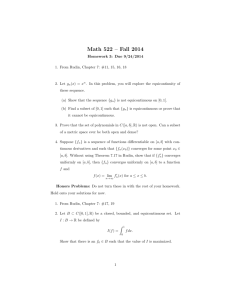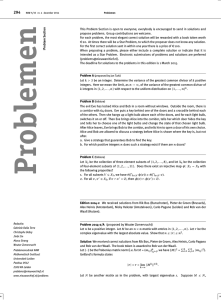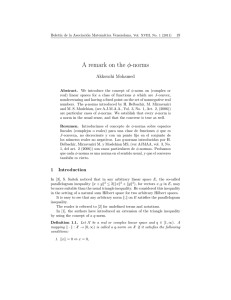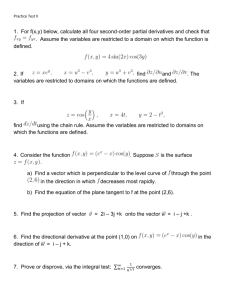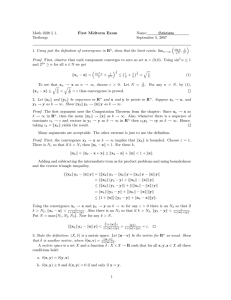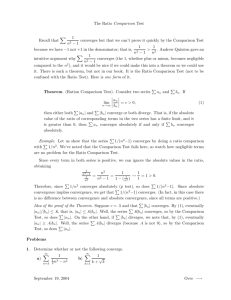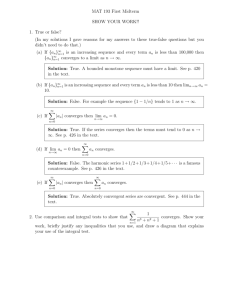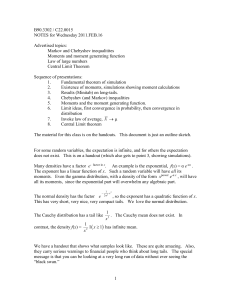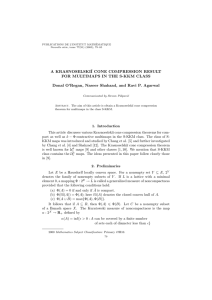Homework #2 solutions - Electrical Engineering & Computer Sciences
advertisement
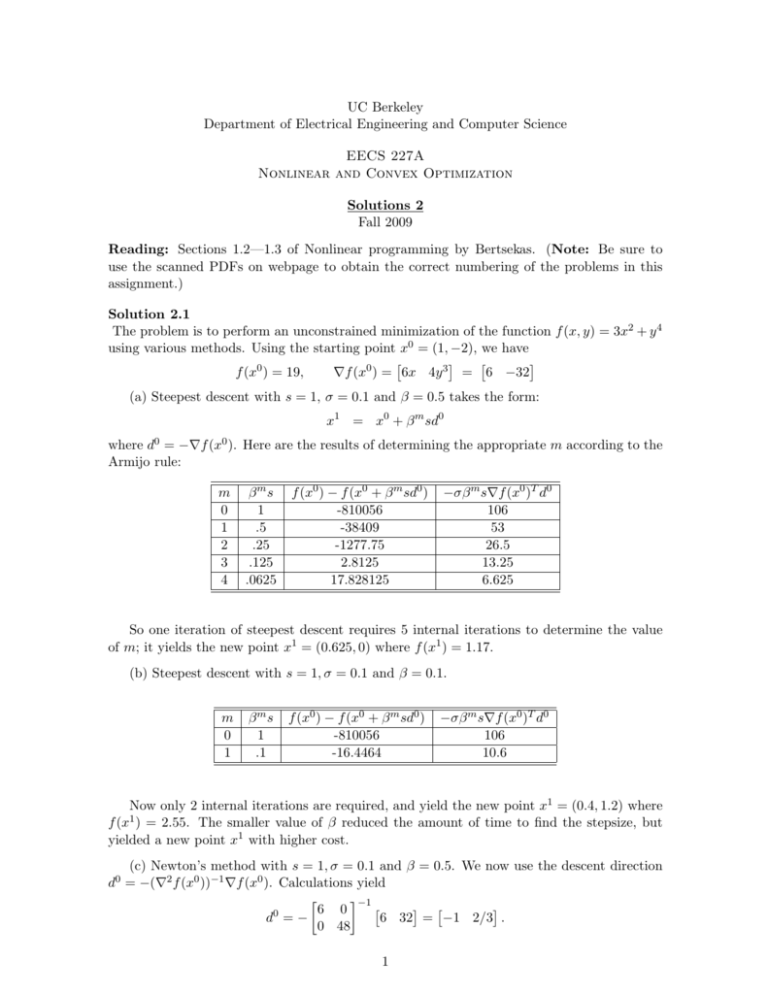
UC Berkeley
Department of Electrical Engineering and Computer Science
EECS 227A
Nonlinear and Convex Optimization
Solutions 2
Fall 2009
Reading: Sections 1.2—1.3 of Nonlinear programming by Bertsekas. (Note: Be sure to
use the scanned PDFs on webpage to obtain the correct numbering of the problems in this
assignment.)
Solution 2.1
The problem is to perform an unconstrained minimization of the function f (x, y) = 3x2 + y 4
using various methods. Using the starting point x0 = (1, −2), we have
f (x0 ) = 19,
∇f (x0 ) = 6x 4y 3 = 6 −32
(a) Steepest descent with s = 1, σ = 0.1 and β = 0.5 takes the form:
x1 = x0 + β m sd0
where d0 = −∇f (x0 ). Here are the results of determining the appropriate m according to the
Armijo rule:
m
0
1
2
3
4
βms
1
.5
.25
.125
.0625
f (x0 ) − f (x0 + β m sd0 )
-810056
-38409
-1277.75
2.8125
17.828125
−σβ m s∇f (x0 )T d0
106
53
26.5
13.25
6.625
So one iteration of steepest descent requires 5 internal iterations to determine the value
of m; it yields the new point x1 = (0.625, 0) where f (x1 ) = 1.17.
(b) Steepest descent with s = 1, σ = 0.1 and β = 0.1.
m
0
1
βms
1
.1
f (x0 ) − f (x0 + β m sd0 )
-810056
-16.4464
−σβ m s∇f (x0 )T d0
106
10.6
Now only 2 internal iterations are required, and yield the new point x1 = (0.4, 1.2) where
f (x1 ) = 2.55. The smaller value of β reduced the amount of time to find the stepsize, but
yielded a new point x1 with higher cost.
(c) Newton’s method with s = 1, σ = 0.1 and β = 0.5. We now use the descent direction
d0 = −(∇2 f (x0 ))−1 ∇f (x0 ). Calculations yield
−1
6 0
0
6 32 = −1 2/3 .
d =−
0 48
1
m
0
βms
1
f (x0 ) − f (x0 + β m sd0 )
15.8395
−σβ m s∇f (x0 )T d0
2.733
So one iteration of Newton’s method requires only 1 internal iteration to determine m, and
yields x1 = (0, −4/3)0 with f (x1 ) = 3.1605. Although fewer internal iterations were required,
the cost of the resulting x1 is higher. In this case, determining the descent direction (involving
the inverse of the Hessian) was straightforward, but this calculation is potentially expensive.
Solution 2.2
Since ∇f (x) = (2 + β)kxkβ x, we have
x
k+1
k β
k
= (1 − s(2 + β)kx k )x ⇒ kx
k+1
k β
k = 1 − s(2 + β)kx k kxk k
Let γ k = 1 − s(2 + β)kxk kβ . So γ k ≤ 1, ∀k and we also have kxk+1 k = γ k kxk k
• If γ 0 < −1 then kx1 k > kx0 k, so γ 1 < γ 0 < −1. Similarly, γ k < −1, ∀k.
Therefore {kxk k} is strictly increasing, hence it does not converge.
• If γ 0 = −1 then x1 = −x0 , similarly xk+1 = −xk . So {xk } converges only if x0 = 0
which contradicts with γ 0 = −1
• If −1 < γ 0 < 1 (s > 0), then kx1 k < kx0 k, so γ 1 > γ 0 > −1. Similarly, γ k > −1, ∀k.
Therefore kxk k is decreasing and bounded below (by 0), so it converges to x∗ .
x∗ = (1 − s(2 + β)kx∗ kβ )x∗ ⇒ x∗ = 0
• If γ 0 = 1 then x1 = x0 , thus xk = x0 , ∀k. The sequence also converges to x0
In summary, {xk } converges to x∗ = 0 if and only if x0 = 0 or 0 < s <
2
(2 + β)kx0 kβ
Solution 2.3
1
Notice ∇f (x) = 23 kxk− 2 x, and let y = −x then
1
k∇f (x) − ∇f (y)k
3
= kxk− 2 → ∞ as x → 0
kx − yk
2
Therefore, the Lipschitz condition does not hold.
2
It is easy to see that if kxk k = 9s4 for some k then the steepest descent algorithm converges
to 0 in finite iterations.
It remains to show that the algorithm does not converges in infinite steps. If this is not true,
then
∀ > 0, ∃N = N () : ∀k ≥ N, kxk k < 2
Let = 2s , then
k
3
k+1
k
−1/2
kx k > 2kxk k
kx k = 1 − skx k
2
2
So eventually, kxk k > which is a contradiction.
Solution 2.4
Our approach is to show that {dk } thus defined satisfies the gradient-relatedness condition.
Let {xk } be any subsequence that converges to a non-stationary point x̄ (so that ∇f (x̄) 6= 0).
Since f is continuously differentiable, we also have ∇f (xk ) → ∇f (x̄). Now the definition of
the direction dk yields that
kdk k22
n
X
2
=
(dki )2 = k∇f (xk )k∞
i=1
∂f
where k∇f (xk )k∞ : = maxi=1,...n | ∂x
(xk )|. Since ∇f (xk ) converges to ∇f (x̄), it is bounded
i
and hence dk is also bounded. Moreover, it holds that ∇f (xk )T dk = −k∇f (xk )k2∞ . Thus,
∇f (xk )T dk
k∇f (xk )k2 kdk k2
−k∇f (xk )k2∞
k∇f (xk )k2 k∇f (xk )k∞
−k∇f (xk )k∞
,
k∇f (xk )k2
=
=
which stays bounded away from zero since ∇f (xk ) converges to a non-stationary point by
assumption. Thus, the sequence {dk } is gradient-related, so that every limit point must be
stationary by the result proved in class.
Solution 2.5
Notice that ∇f (x) = Qx, so
xk+1 = xk − αQxk = (I − αQ)xk ⇒ xk = (I − αQ)k x0
Note that if (λ, u) is eigen-pair of Q then (1 − αλ, u) is an eigen-pair of A := I − αQ
n
0
0
Since
Pn Q is invertible, its eigenvectors form a basis of R , so x can be written as x =
i=1 βi ui , so
n
n
X
X
x k = Ak x 0 =
βi Ak ui =
βi (1 − αλi )k ui
i=1
i=1
)k
Notice that if λi < 0 then 1 − αλi > 1 so (1 − αλi → ∞ as k → ∞.
Therefore, unless x0 belongs to the subspace spanned by the eigenvectors of Q corresponding
to the non-negative eigenvalues, the sequence {xk } diverges.
Solution 2.6
1
f (x, y) =
2
2
1.999
where Q =
1.999
2
The rate of convergence is
x
y
T
Q
x
y
. Eigenvalues of Q are m = 0.001 and M = 3.999
M −m
M +m
2
= 0.9990
3
A starting point for which the convergence rate is sharp:
1/m
−706.9300
0
x =U
=
1/M
707.2836
(By transforming u = U x where Q = U ΛU T is the eigen-decomposition of Q, we get f (x) =
g(u) = mu21 + M u22 )
(See Figure 1.3.2, p61 Nonlinear programming)
Solution 2.7
Without loss of generality, we assume that x∗ = 0. (If not, we simply apply the transformation
y = x − x∗ to the problem.) The update then takes the form
xk+1 = (I − sQ)xk − sek .
Using the triangle inequality, we have
kxk k ≤ k(I − sQ)xk−1 k + skek−1 k
≤ qkxk−1 k + sδ
where k(I − sQ)xk−1 k ≤ qkxk−1 k follows from the same argument as used in class. Applying
this inequality recursively yields
h
i
kxk k ≤ q qkxk−2 k + sδ + sδ
..
.
..
.
..
.
≤ q k kx0 k + sδ
k−1
X
qi
i=0
sδ
≤ q k kx0 k +
1−q
where the final line uses the fact that for q ∈ [0, 1)
k−1
X
i
q ≤
i=0
∞
X
i=0
qi =
1
.
1−q
Solution 2.8
(a) Note that x∗ = −Q−1 c is the optimal solution. So by a change of variables (consider
x ← x − x∗ ), we can assume c = 0 WLOG.
Since ∇f (x) = Qx, we have
xk+1 = xk − αQxk + β(xk − xk−1 ) = ((1 + β)I − αQ)xk − βxk−1
So
xk+1
xk
=
(1 + β)I − αQ −βI
I
0
4
xk
xk−1
Let
yk
=
xk
xk−1
and A =
(1 + β)I − αQ −βI
I
0
, above equation is equivalent
to
y k+1 = Ay k
Suppose v is eigenvalue of A,
(1 + β)I − αQ −βI
x
x
=v
⇒ αQx = (1 + β − v − β/v)x
I
0
y
y
Hence 1 + β − v − β/v = αλ (*) for some eigenvalue λ of Q.
2(1 + β)
2(1 + β)
≤
then 0 < αλi (Q) < 2(1 + β), ∀i.
If 0 < α <
M
λi (Q)
Therefore, −(1 + β) < λi (A) + β/λi (A) < (1 + β), which implies |λi (A)| < 1, ∀i.
Let γ = kAk2 = max{|λi (A)} < 1, we have
ky k+1 k = kAy k k ≤ kAk2 ky k k = γky k k
The sequence {y k } thus converges linearly with the rate of γ, so is {xk }.
By solving (*) for v, we have
p
1
v=
1 + β − αλ ± (1 + β − αλ)2 − 4β
2
(Note that v might be complex number.)
Therefore,
p
1 γ = max
1 + β − αλ ± (1 + β − αλ)2 − 4β λ∈{λi (Q)} 2
We choose α, β as following
4
,β =
α= √
√
( M + m)2
√
√ !2
M− m
√
√
M+ m
We have, for any λ ∈ {λi (Q)}
p
1 1 + β − αλ ± (1 + β − αλ)2 − 4β 2
v
!2 u
√
√
1 2(M + m − 2λ) u
4(M + m − 2λ)2
M − m t
√
=
±
−4 √
√
√
√
√
2 ( M + m)2
( M + m)4
M + m p
1
2 − (M − m)2 = √
(M
+
m
−
2λ)
±
(M
+
m
−
2λ)
√
( M + m)2 p
1
= √
√ 2 (M + m − 2λ) ± 2 (M − λ)(m − λ)
( M + m) p
1
= √
(M
+
m
−
2λ)
±
2i
(M
−
λ)(λ
−
m)
(since m ≤ λ ≤ M )
√ 2
( M + m)
p
1
= √
√ 2 (M + m − 2λ)2 + 4(M − λ)(λ − m)
( M + m)
√
√
M −m
M− m
= √
=√
√
√
( M + m)2
M+ m
5
Therefore the corresponding convergence rate is
√
√
M− m
γ=√
√
M+ m
Note: To find optimal α, β we would solve the following problem
p
1 (α∗ , β ∗ ) = arg min max
1 + β − αλ ± (1 + β − αλ)2 − 4β α,β λ∈{λi (Q)} 2
With careful derivations (complex number issue), one can prove that the above values
for α, β are the optimal solution.
In many cases, the solution of min maxn f (θ, λ) often satisfies f (θ∗ , λi ) = c, ∀i.
θ
λ∈{λi }i=1
(b) Assuming that the parameter β is appropriately chosen, it is a reasonable conjecture
that the method would have better behavior for functions with varying steepness. We
provide empirical support for this conjecture with our experimental results reported in
the following part.
(c) For f (x) = 12 x2 (1 + γ cos(x)),
1
f 0 (x) = x + γx cos(x) − γx2 sin(x).
2
The following four plots show successive iterates and the total number of iterations for
four different choices of β, where the final plot shows β = 0, corrresponding to steepest
descent. For the intermediate value of β = 0.5, fewer iterations are required overall. For
too large values of β, the method overshoots.
6
7
8
For the function f (x) =
1
2
Pm
f 0 (x) =
i=1 |zi
− tanh(xyi )|2 , we have
n
X
(tanh(xyi ) − zi )(1 − tanh(xyi )2 )yi
i=1
9
10
function [ x opt , n i t e r ] = h e a v y b a l l ( alpha , beta , e p s i l o n , x i n i t )
% R e p l a c e your f u n c t i o n d e f i n i t i o n h e r e
gamma = 0 . 5 ;
f = @( x ) 0 . 5 ∗ x . ˆ 2 . ∗ ( 1 + cos ( x ) ) ;
g r a d f = @( x ) x + gamma∗x ∗ ( cos ( x ) − 0 . 5 ∗ x∗ sin ( x ) ) ;
r a n g e = [ −1.5∗ pi : 0 . 0 1 : 1 . 5 ∗ pi ] ;
plot ( range , f ( r a n g e ) ) ; hold on ;
x = [ x init x init ];
dist = inf ;
n iter = 0;
while d i s t > e p s i l o n
x new = x ( end ) − a l p h a ∗ g r a d f ( x ( end ) ) + beta ∗ ( x ( end)−x ( end − 1 ) ) ;
d i s t = abs ( x new − x ( end ) ) ;
x = [ x x new ] ;
n iter = n iter + 1;
end
x o p t = x ( end ) ;
plot ( x , f ( x ) , ’ rx ’ ) ; hold on ;
end
11

![MA3422 (Functional Analysis 2) Tutorial sheet 6 [March 6, 2015] Name:](http://s2.studylib.net/store/data/010731575_1-06b5661c3a20b11a18d808d1b2facc3f-300x300.png)
